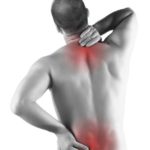By Bonnie Jenkins, Advanced Natural Wellness
If you’re a weekend warrior, Monday morning back pain is nothing new. But living with chronic back pain – when even the smallest movement can be agony – can be debilitating.
Unfortunately, back pain, which includes neck pain and sciatica, is extremely common. And it affects 80 percent of Americans at some point. So it’s no surprise that low-back pain is among the most common reasons for medical appointments. But this pain is normally a symptom of another underlying condition, not a diagnosis. And it may come from a problem with your nerves, discs, muscles or even because of osteoarthritis.
Green Back
According to a recent study, Americans spend more money treating back and neck pain than almost any other medical condition, but a lot of that money may be wasted. Between 1997 and 2005, total medical costs for back and neck pain increased by 65 percent – or about $86 billion a year in today’s dollars. Still, during those years, patients actually experienced more disability from back and neck pain, along with more depression and physical limitations.
Today, those with back pain spend nearly twice as much for medical care each year as those without. In fact, back pain expenses have risen faster than other health care costs. But it isn’t because of surgical procedures or new technology. It’s because many people are trying to manage their pain by using newer – and more addictive – narcotics like Vicodin and OxyContin.
The problem is, University of Washington scientists have found that the nation’s dramatic rise in expenditures for the diagnosis and treatment of back problems hasn’t led to improvements in patient health. Instead, the pain continues to interfere with everyday activities for folk like you and me.
MD Exposes the Hidden Danger to Your Eyes

When your eyesight starts to fail, it's a real problem. Suddenly you can't go to the grocery store... you can't get to the doctor if you have an emergency... you can't meet your friends for dinner…
Your "regular" doctor doesn't have time to keep up with the latest research. And the same goes for eye doctors. They go to school to learn how to fit you for glasses and contacts, but have no way of preventing the damage and loss of eyesight that threatens your freedom and independence.
Let me show you something that explains a LOT about how your eyes work.
In my FREE Special Report, I'll show you a HUGE, untapped resource for your eyes that safely and naturally restores clear, effortless eyesight.
Click here to get started...
Nature’s Aspirin
If you’re among those suffering from chronic back pain, take heart. Instead of dubious narcotics, there are some simple, safe and effective ways to keep a lid on your pain. Willow bark, for instance, is a natural pain reliever that lives up to its reputation. The bark contains salicin – the herbal forerunner of aspirin – which relieves pain and eases inflammation.
An Israeli study confirmed the herb’s use for back pain. Subjects were given an extract containing either 120 mg. or 240 mg. of salicin per day. After just one week, the participants reported significant relief. And the benefit appeared to be dose-dependant. The higher the dose, the more effective the outcome.
Willow bark has even proven to be just as effective as prescription painkillers. In a University of Sydney study, researchers compared the effects of willow bark extract to Vioxx, a COX-2 inhibitor pain medication that was recalled for safety reasons in 2004. When 114 patients received an herbal extract containing 240 mg. of salicin, and 114 received 12.5 mg of Vioxx every day, both sets of subjects had a comparable reduction in back pain after four weeks.
Unlike aspirin, willow bark won’t cause bleeding problems. But, although this herb probably doesn’t thin the blood, it’s a good idea to talk to your doctor if you are taking a blood thinning medication. For best results, take an extract containing 240 mg. salicin per day.
Tamp Down Inflammation
Tumeric is another potent pain reliever, thanks to its active ingredient, curcumin. Curcumin, the compound that creates turmeric’s distinctive yellow color, has anti-inflammatory effects comparable to the drug prednisone. But unlike prednisone, curcumin is non-steroidal, so it has no negative side effects.
Are You Suffering From...
- Love handles and a pot belly
- Romance that isn't what it used to
- Forgetfulness and inattention
- Low (or no) strength and endurance
- A sex drive that's shifted into neutral...or worse
If so...you may have Mature Male Burnout. Click here to discover more about this unique condition and what you can do about it.
Curcumin treats pain by stimulating the production of nitric oxide, a pain-reducing chemical messenger. It also suppresses pain through a mechanism similar to many prescription drugs.
If you have acute back pain, willow bark is probably your best bet. But for ongoing pain relief, use 1,500 mg. of a standardized curcumin daily. You can also add tumeric to soups, stew and casseroles for a bit of extra relief.
One Last Thing …
Fighting back pain from the inside is a good strategy. But you can also attack back problems from the outside. Capsaicin is the active ingredient that gives cayenne peppers their kick, and it’s also the chemical that kills pain. Applied to skin, cayenne ointment containing capsaicin depletes substance P – a neurochemical that transmits pain – reducing pain signals in nerves.
Just be aware that there may be a delay of up to two weeks before you experience any pain relief. During the first few days, you may feel a burning sensation as the nerve cells release their substance P. Once the cells are depleted, pain decreases.
Look for an ointment or cream containing capsaicin and apply a pea-sized amount to the affected area up to three times daily. Rub in well. You will feel the area become warm and, with continuous use, experience a reduction in pain. But because capsaicin is so potent, never use this remedy on sensitive or broken skin.
This Just in …
Recently, I told you about the dangers of using plastic for food and drinks. But now, there’s even more reason to avoid this bane of modern life. According to a new study by British researchers, the bisphenol A (BPA) in plastics is also implicated in heart disease and diabetes.
Using data from the National Health and Nutrition Examination Survey, which measured urinary BPA concentrations in 1,455 adults, the researchers compared levels of the chemical in the participants with those who were later diagnosed with cardiovascular disease or diabetes. It turns out that high levels of BPA were associated with a 39 percent higher risk of both heart disease and diabetes. What’s more, higher levels of BPA were linked to abnormal concentrations of three liver enzymes.
Since this study on BPA involved real people instead of lab rats, the FDA might take a second look. But, if the agency charged with the safety of the foods we eat drags its heels or fails to act, you can take matters into your own hands.
Start opting for safer ways to store, cook and serve your food. Switch to containers made from glass when possible. Look in your local health food store for deli containers made from corn or other biodegradable material. If you must buy food in plastic, transfer it to a safer container when you get home. And don’t forget two popular choices used by our grandmothers – waxed paper and freezer paper. Although things won’t stay fresh quite as long as if they were stored in plastic, at least you’ll know you aren’t getting any “extras” in the foods you eat.
References:
Chrubasik S, Künzel O, Model A, et al. “Treatment of low back pain with a herbal or synthetic anti-rheumatic: a randomized controlled study. Willow bark extract for low back pain.” Rheumatology. 2001;40:1388-1393.
“Higher urinary levels of commonly used chemical, BPA, linked with cardiovascular disease, diabetes.” EurekaAlert! September 2008:16.
Keitel W, Frerick H, Kuhn U, et al. “Capsicum pain plaster in chronic non-specific low back pain.” Arzneimittelforschung. 2001;51:896-903.
Martin BI, Deyo RA, Mirza SK, et al. “Expenditures and health status among adults with back and neck problems.” Journal of the American Medical Association. 2008; 299:656-664






